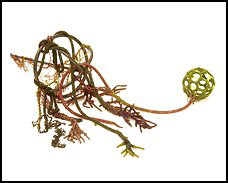
Gail Gorlitzz's "Sea Weave" at the Glass Gallery in Bethesda. (Jay Mallin)
By Michael O'Sullivan
Washington Post Staff Writer
Friday, November 5, 2004; Page WE52
AFIRST IMPRESSION of some of Gail Gorlitzz's bead sculptures, on view at Bethesda's Glass Gallery, is that someone must have thrown a firecracker into a case of Judith Leiber handbags. Gorlitzz's forms are loopy, loose-limbed and unrecognizable as useful objects, while the famous designer's work is tight, fussy and (despite their small size) functional. As far away from jewelry as you can get, Gorlitzz's biomorphic semiabstractions are not the kind of thing one thinks of when one thinks of bead art.
She's probably closer to a Joyce J. Scott or a Liza Lou, but Gorlitzz avoids both the explicit politics of the former (while retaining Scott's interest in gender) and the literal-minded representation of the latter (while retaining some of Lou's whimsy). Whatever her work is, one thing Gorlitzz does not want it to be is, in her words, "pretty."

Gail Gorlitzz's "Sea Weave" at the Glass Gallery in Bethesda. (Jay Mallin)
Except that as soon as she puts it that way, while giving a reporter a tour of the show, she corrects herself: "I don't want them not to be pretty," she explains. "I just don't want them only to be pretty."
Gotcha.
You'll know what the artist means when you see her show, which is both homely and lovely. Often inspired by sea forms and what the artist and amateur horticulturist calls "things out of my garden," Gorlitzz's sculpture is, to a large degree, about the body, by which I mean bodies in all their imperfection and fragility. And I don't just mean human ones either. With its suggestion of a heart, or some other organ, the bright red "Little Wound," which references a beloved pet cat that died -- and, in fact, incorporates some of the veterinary tubing used to keep the animal hydrated during its final days -- is a perfect example. Other works possess tails, bladderlike sacs, dangling umbilical cords and, in one case, even something a bit like pubic hair. Hardness plays off against softness in Gorlitzz's temptingly tactile art, which betrays a kind of wacky, Dr. Seussian hermaphroditism. (Privately, the artist says she doesn't mind people touching her work, but you might want to check with gallery management before you do so.)
Beyond the animus/anima, yin/yang dichotomy, Gorlitzz is interested in the tension of other opposites as well. Sure, she's got the whole ugly/pretty thing going on, which she subtly underscores by combining matte beads with shiny ones and flawed beads from Taiwan with perfect ones from Japan, but it goes well beyond material.
Hoping to be taken seriously, yet working in a medium that invites being ghettoized, if not derided, as craft -- a distinction that Gorlitzz finds "false and arbitrary" -- the artist courts, and ultimately seduces, critics with works such as "Precious," whose very title, not to mention lampshade aesthetic, makes a pun on the contradictory definitions of "prized" and "overdone." Think Faberge eggs, with all their baggage of kitsch and collectibility.
Like all her art, "Precious" calls to mind both the familiar and the unknown, the domestic and the foreign, the hidden and the manifest. Often secreted inside her beaded "skins" are various objects -- balls and other toys -- that can only be dimly identified. One piece from a few years back, the vaguely floral "Alien," was inspired by the artist's then-teenage child, who struck her at the time as something of an outlander.
Mixing candlesticks with suture thread, real seed pods with imagined ones, Christmas ornaments with snakes made of Sculpey modeling clay, Gorlitzz fashions crazy, beaded sculptures that bedevil easy analysis. Their delicacy is a kind of strength. Like people, their power lies in their breakability.